| Why I Knit with Handspun
I know spinners who never knit with their handspun; they sell it, give it away, or just stash it. There are knitters who are contemplating making the spinning move, but don't really plan to knit with their yarn because they look at it as separate from knitting and they think their yarn won't be good enough to knit with. I think that's crazy. I love knitting with handspun -- there is nothing else like it.

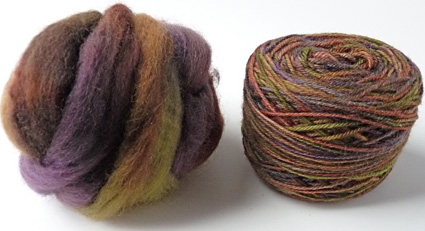 |
Yarn Hollow 100% BFL top, Photograph 100% BFL DK yarn, color: Chai
|
This reboot of the Knittyspin column is going to be about just that, knitting with handspun -- spinning yarn with knitting in mind, then knitting with it. After all that's why we started Knittyspin, to have patterns and information for knitters who spin or spinners who knit.
I thought I'd kick off this column by talking about why I love spinning to knit. I especially love working with wool and wool blends, but that's not all I spin and knit.
The photos scattered through this column are of fiber and yarn from Yarn Hollow. I asked Rita to dye some of her Photograph, a BFL commercial yarn, and some of her BFL top in a matching colorway, Chai. I spun and knit both while working on this column to help focus my thinking. I knit the yarn into a stockinette swatch and spun the fiber seven different ways and knit them in simple stockinette.
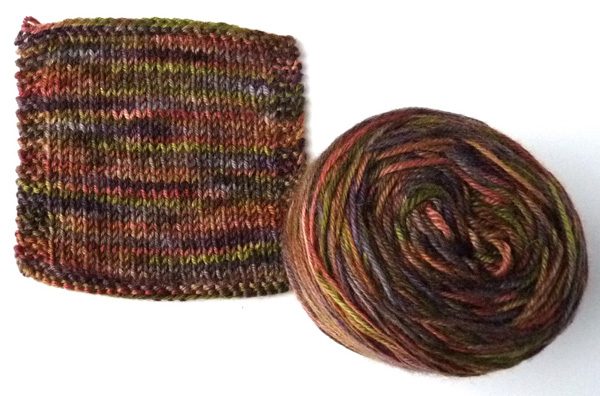 |
Photograph, 3 ply, commercially spun, hand dyed yarn
|
I could do an interpretive dance like I sometimes do about things I'm really into, but I thought it might be more useful (and persuasive) to tell you the five reasons why I spin to knit: Choice, Control, Craft, Creativity and Continuum.
Choice
I love having choices. Sometimes I choose a commercial yarn because it's just right. But nothing looks and feels like handspun yarn.
I have yet to knit with a commercial yarn that feels like handspun. Commercial yarn is prepped and spun by machines that hold it under a lot more tension than most spinners would. That tension stretches a little bit of the life, the spring, out of the yarn. Then it's wound by machine and stacked in boxes, stretching and compressing the fibers more. All this machinery gives a mill an easily repeatable and predictable yarn. To me, commercial yarns can seem a little limp.
Handspun yarn seems alive to me, almost like it breathes. It's brash and energetic. It can be uneven and sometime a little unpredictable, but that adds to the excitement of knitting with it; it's never boring.
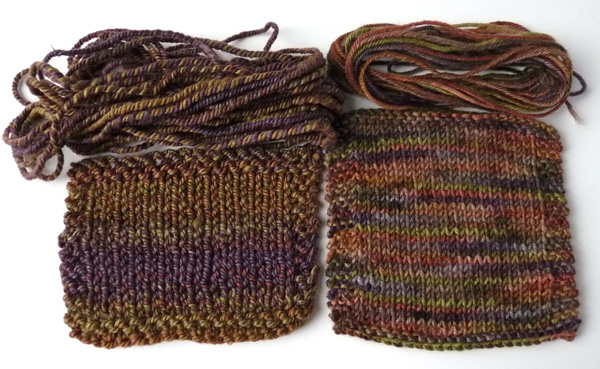 |
Handspun 3 ply on the left, commercially spun 3 ply on the right
|
Because spinning fiber is usually dyed before it's spun, the colors in handspun are deeper and I'm able to manipulate how colors fall when spinning from variegated tops and rovings in yarn. Sometimes I want very clear cut colors, sometimes I want them muddied or blended or in a different order.
The finished fabric is somehow different, too. It looks vibrant and feels lively. It has personality and attitude.
Even when I spin to just spin with nothing particular in mind, I always knit a little. It never feels quite done until I hold that little swatch.
Control
I won't deny that one of the things I love about knitting with handspun is the control over creating the yarn. Sometimes it feels like there are a million different options when it comes to spinning yarn. I narrow it down to seven things and ask myself lots of questions.
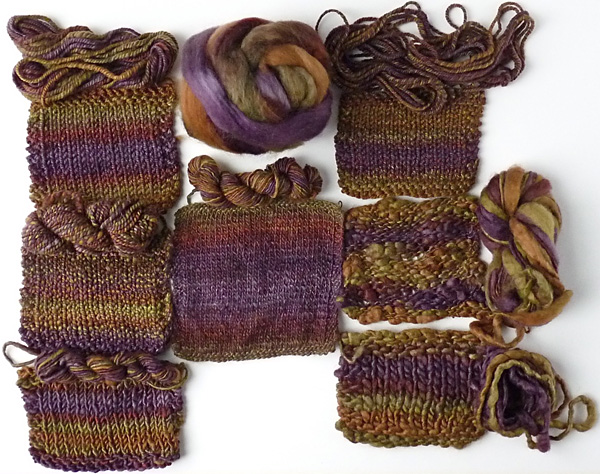 |
BFL fiber spun seven different ways
|
Intention
What am I spinning for? Am I interpreting a commercial or handspun yarn for a pattern? Am I spinning yarn first then finding a pattern? Am I just spinning to spin? What type of yarn do I want to end up with?
Breed and Fiber
Thanks to Clara Parkes, Deb Robson and Beth Smith, I think spinners and knitters know there are different sheep breeds and the wool from each have different properties that lend themselves to particular yarns. Non-wool fibers -- animal, plant or manmade -- all help yarn feel and look a particular way too. What am I looking for in my yarn? What will I use it for? Does a kernel of it lie in breed or fiber choice?
Prep
Am I starting with a fleece or commercially prepared fiber? How will I prepre the fleece? How was the commercial fiber prepared? Each preparation method, no matter the fiber, influences the finished yarn. What do I need for the yarn in my mind?
Color
Am I dyeing my fiber? What colors? Will I dye before or after I prepare my fiber? Before or after the yarn is spun?
If I'm using gorgeously dyed top/roving or batts, will I spin the colors as they are or manipulate the color flow somehow? Will I combine the colors with another dyed fiber? Will I combine colors in the draft or ply?
Draft
Do I want compact or lofty yarn? Smooth or textured yarn? Somewhere in between? Am I blending colors here? Am I working with or against the preparation? How much twist do I want?
 |
Singles yarn, bulky and fine
|
Ply
Am I plying? How many plies? Am I blending colors here? Do I want a textured or art ply? How much ply twist do I want?
Finish
How will I finish it? Will I full or felt? Will I whack, snap or just hang? Is there any reason to block the yarn?
Whew! It seems like a lot but I mostly do all of this in my head in a minute or two. When I'm planning a big or very specific project, I sit and write it all out.
Craft
This is the making part, the hands on part. This is the part where I grow as a spinner and a knitter by spinning the yarn I knit with. It's an ongoing conversation back and forth, round and round, between the starting fiber, the finished knitted yarn and all of the steps in between. My craft is constantly evolving based on curiosity, experience, obsession, trial and error.
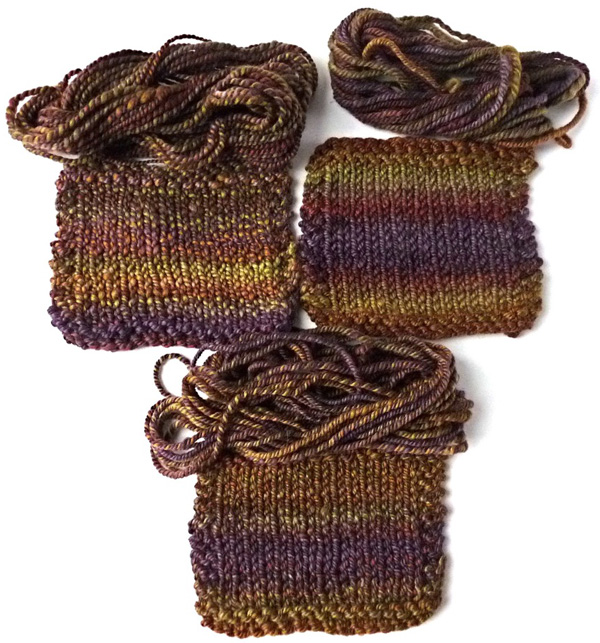 |
Plied yarns -- top: 2-ply, chain ply; bottom, 3-ply
|
The learning, the questing and questioning -- this might be my favorite part.
I am perpetually asking questions, things like...
- I want to make a yarn like this commercial yarn: How do I reverse engineer it?
- I tried to make a yarn for this and it's a disaster: What went wrong?
- I hate one of the colors in this variegated roving: What can I do to save it?
- I love this dyed fiber in the braid. Spun and knit, it's gross and pooly: What should I have done differently?
- I want to spin a particular type of yarn: how do I learn? Who do I talk to? Who do I take a lesson from?
- What should I read?
Creativity
The originality of handspun yarn is astonishing. No two spinners will spin an identical yarn given the same wheel, fiber and parameters. It can have the same twist, wpi and gauge but somehow it won't look the same. There's just something that each spinner breathes into their yarn when the spin it.
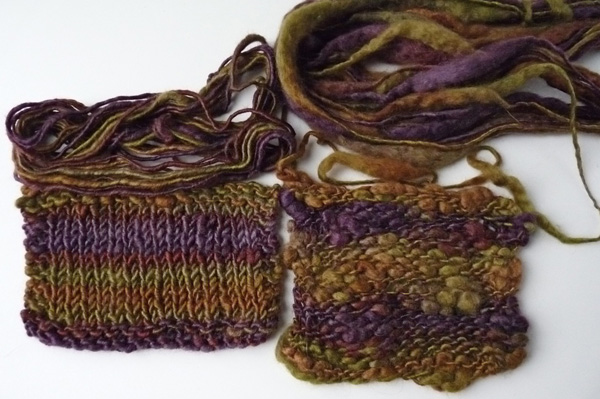 |
Textured yarns: corespun and thick and thin
|
Once I take control of fiber with some intention, my creative mind explodes.
It might be the opposite of what works for you, but giving myself even a small parameter like" spin yarn for a shawl" guides my thinking to be more creative. It plucks my brain out of the overwhelm of all-the-possibilities and narrows it down to shawl yarn. Now that's just 650 ideas to sort through.
Continuum
I love being part of something that reaches forward, back and that has a vibrant now. I may not always be in the thick of it posting on Ravelry (I'm shy that way) but I love the underground rumble I always feel. I love that when I have an idea or question, I can look at old books and magazines and look online and find a variety of answers and opinions. I love that when new magazines, books or conversations come up, there is always something new -- a new twist, a new something to try, a new process.
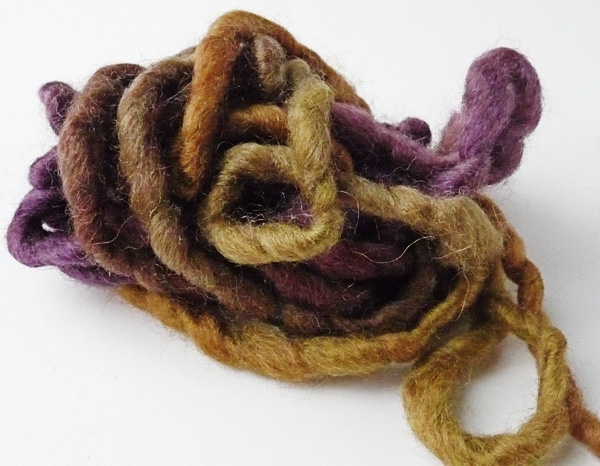 |
Bulky single
|
Person-to-person spinning energy is crazy. Spinning with friends, going to a fiber sale, a class, a retreat or one of the big events I am always full and exhausted afterwards. It takes me a while to process the things I learned and even longer to try them out.
There is such a feeling of process and liveliness when spinners get together; it's the best really.
Are you ready to spin to knit? Next issue we'll get started hands-on.
|

